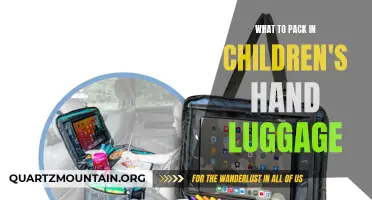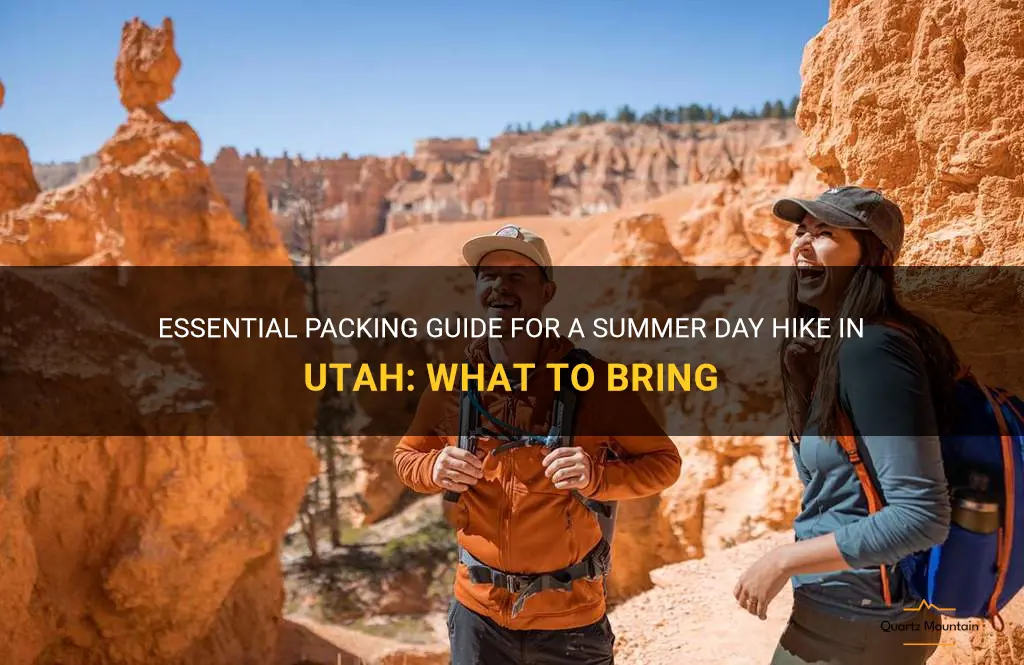
Utah is renowned for its stunning landscapes, from the towering red rock formations of Zion National Park to the lush alpine meadows of the Wasatch Mountains. With such vast and diverse terrain, it's no wonder that hiking is a popular activity for locals and tourists alike. However, when it comes to embarking on a summer day hike in Utah, it's essential to come prepared. From water bottles to sunscreen and proper footwear, this essential packing guide will ensure you have everything you need to enjoy a safe and enjoyable adventure in the great outdoors of Utah.
| Characteristics | Values |
|---|---|
| Duration | Half day to full day |
| Distance | Less than 10 miles |
| Terrain | Mostly flat with moderate elevation gain |
| Weather | Hot and dry |
| Temperature | 80-100°F |
| Clothing | Lightweight and breathable |
| Sun Protection | Hat, sunglasses, and sunscreen |
| Footwear | Comfortable hiking shoes or boots |
| Backpack | Daypack (20-30L) |
| Water | At least 2 liters |
| Food | Snacks and lunch |
| Navigation | Map, compass, or GPS |
| First Aid Kit | Band-aids, antiseptic, and pain relievers |
| Insect Protection | Bug spray and/or mosquito net |
| Emergency Supplies | Whistle, emergency blanket, and headlamp |
| Camera or phone | for capturing memories and emergencies |
| Personal ID and Contact | In case of emergency |
| Optional Extras | Binoculars, trekking poles, and a hat clip |
| Leave No Trace Principles | Pack out what you pack in and respect nature |
What You'll Learn
- What essential items should I pack for a light day hike in Utah during the summer?
- Are there any specific clothing items that are recommended for hiking in the hot Utah summer temperatures?
- What type of footwear is best for a light day hike in Utah's summer heat?
- Are there any particular safety items or equipment that I should bring on a day hike in Utah?
- Are there any specific food and water recommendations for staying hydrated during a summer hike in Utah?

What essential items should I pack for a light day hike in Utah during the summer?
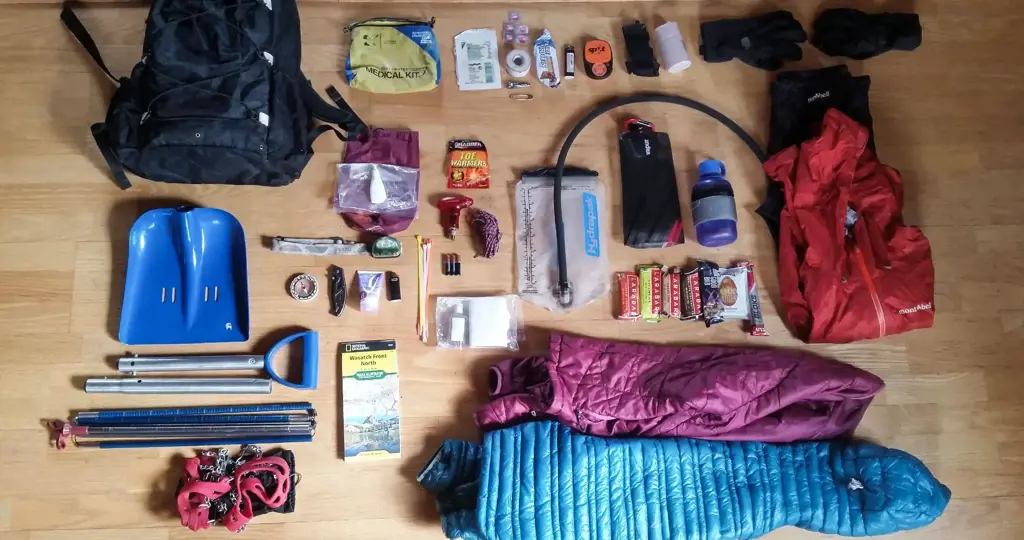
When embarking on a day hike in Utah during the summer, it is important to pack essential items to ensure a safe and enjoyable experience. The hot and arid climate in Utah can pose unique challenges, so being prepared is crucial. Here is a list of essential items to pack for a light day hike in Utah during the summer:
- Water: Staying hydrated is crucial, especially in the desert climate of Utah. It is recommended to carry at least one liter of water per hour of hiking. Consider investing in a hydration bladder or water bottles with built-in filters for convenience.
- Sunscreen: The sun's rays can be particularly intense in Utah, so protecting your skin from harmful UV rays is essential. Choose a sunscreen with a high SPF rating and apply it generously before and during your hike. Don't forget to cover exposed areas like your face, neck, and ears.
- Hat and sunglasses: Along with sunscreen, a wide-brimmed hat and sunglasses can provide additional protection against the sun. A hat will help shade your face and neck, while sunglasses will protect your eyes from the harsh glare.
- Lightweight and breathable clothing: Opt for lightweight, breathable clothing that will keep you cool and comfortable in the heat. Choose moisture-wicking fabrics that dry quickly and avoid cotton, as it retains moisture and can make you feel clammy.
- Hiking shoes or boots: A sturdy pair of hiking shoes or boots will provide the necessary support and traction for navigating various terrains in Utah. Look for shoes with good grip and ankle support to prevent injury.
- Navigation tools: It is always important to have a map, compass, or GPS device to navigate your way on the trail. Familiarize yourself with the route before setting off and keep your navigation tools easily accessible.
- Snacks and food: Pack lightweight and energizing snacks to keep your energy levels up during the hike. Consider trail mix, energy bars, or fresh fruit. Additionally, bring a packed lunch if planning to spend an extended time on the trail.
- First aid kit: Accidents and injuries can happen on the trail, so it's important to have a basic first aid kit on hand. It should include essentials such as bandages, adhesive tape, antiseptic wipes, pain relievers, and any necessary prescription medications.
- Insect repellent: Utah is home to various insects, including mosquitoes and ticks. Protect yourself from bites by applying insect repellent to exposed skin. Look for a product that contains DEET, picaridin, or lemon eucalyptus oil for maximum effectiveness.
- Emergency supplies: While it is always best to be prepared and avoid emergencies, it is essential to have emergency supplies on hand. Consider carrying a whistle, emergency blanket, light source (such as a headlamp or flashlight), and a fully charged cell phone.
By packing these essential items, you will be well-prepared for a light day hike in Utah during the summer. Remember to always check weather forecasts, trail conditions, and let someone know your hiking plans before setting off. Safety should always be a top priority when exploring the beautiful wilderness of Utah.
Essential Items to Pack for an Unforgettable Road Trip
You may want to see also

Are there any specific clothing items that are recommended for hiking in the hot Utah summer temperatures?
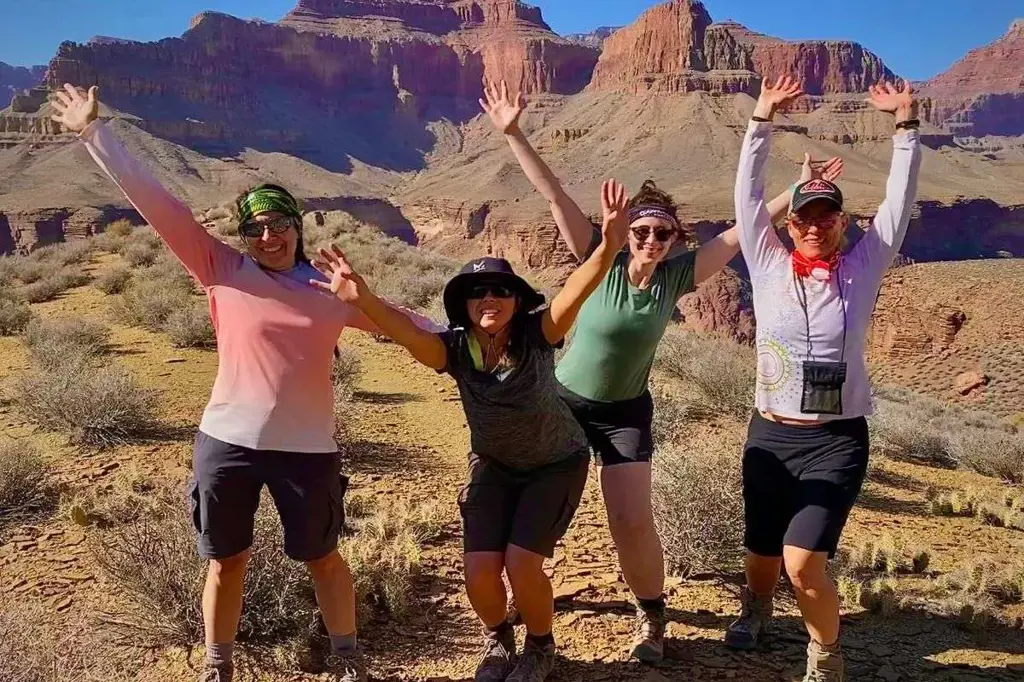
When hiking in the hot Utah summer temperatures, it is essential to wear clothing that helps keep you cool and protected from the sun. By choosing the right clothing items, you can enjoy your hiking experience without feeling overwhelmed by the heat. Here are some specific clothing recommendations for hiking in the hot Utah summer temperatures:
- Lightweight and breathable fabrics: Opt for clothing made from lightweight and breathable fabrics such as cotton, linen, or moisture-wicking materials like polyester or nylon. These fabrics will allow air to circulate and help keep you cool during your hike.
- Long-sleeved shirts: While it may seem counterintuitive to wear long sleeves in the heat, long-sleeved shirts can actually protect your skin from the sun's harmful rays. Look for shirts with built-in sun protection or choose lightweight materials that offer UPF (Ultraviolet Protection Factor) ratings.
- Moisture-wicking and quick-drying materials: Utah's summer temperatures can be scorching, so it's important to choose clothing that will wick away sweat and dry quickly. This will help prevent discomfort from wet clothes and potential chafing.
- Sun hats and caps: Protecting your head from direct sunlight is crucial, especially during long hikes in the hot Utah sun. Wear a wide-brimmed sun hat or a lightweight cap to shield your face and neck from the sun's rays.
- Lightweight and breathable pants: Instead of opting for shorts that leave your legs exposed to the elements, consider wearing lightweight and breathable pants. Look for pants made from materials like nylon or polyester blends that offer both comfort and sun protection.
- Proper footwear: Invest in a pair of sturdy hiking shoes or boots that offer good ventilation. Opt for breathable materials and make sure the shoes fit properly and provide ample support.
- Sunglasses: Protect your eyes from harmful UV rays by wearing sunglasses with UV protection. Look for sunglasses that wrap around your face to block sunlight from all angles.
Remember, staying hydrated is also crucial while hiking in hot temperatures. Wear moisture-wicking socks and don't forget to bring plenty of water and electrolyte-rich beverages to replenish your fluids.
Here's an example of a complete hiking outfit for the hot Utah summer temperatures:
- Lightweight, breathable long-sleeved shirt with UPF protection
- Moisture-wicking and quick-drying shorts or lightweight pants
- Breathable hiking socks
- Sturdy and well-ventilated hiking shoes or boots
- Wide-brimmed sun hat or lightweight cap
- Sunglasses with UV protection
- A small backpack for carrying essentials like water, snacks, and sunblock
By following these clothing recommendations and preparing yourself with the right gear, you can enjoy your hiking adventures in the hot Utah summer temperatures while staying protected and comfortable.
What to Pack for Europe in April: Essential Tips and Recommendations
You may want to see also

What type of footwear is best for a light day hike in Utah's summer heat?
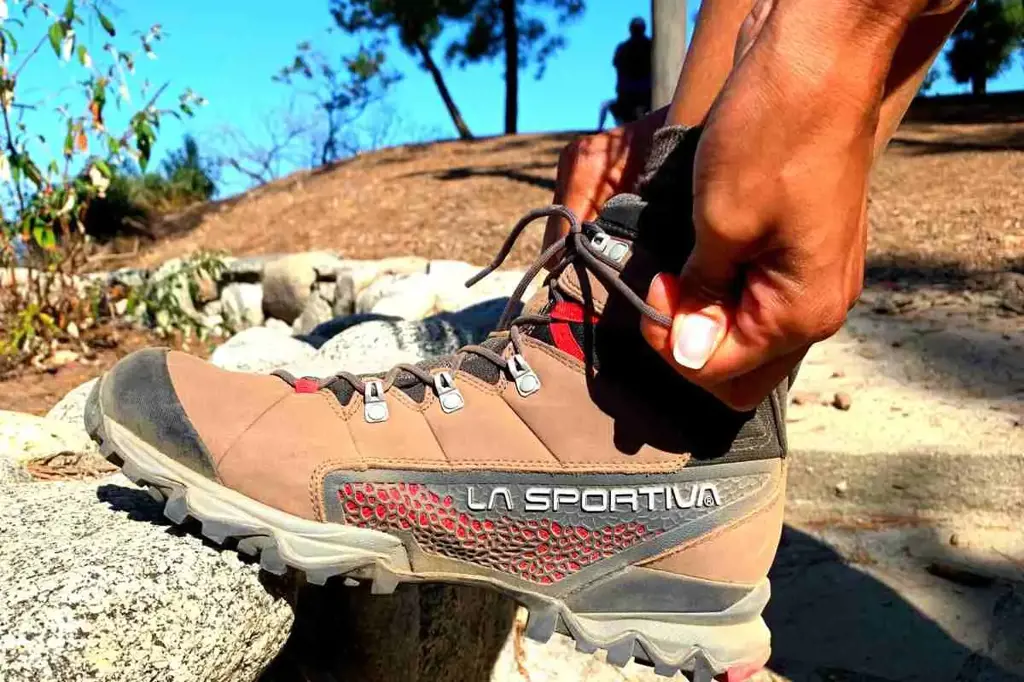
When it comes to a light day hike in Utah's summer heat, choosing the right footwear is crucial for your comfort and safety. The scorching temperatures and rugged terrains require footwear that offers good ventilation, support, and protection. Here is a guide to help you choose the best type of footwear for your summer hike in Utah.
Opt for hiking shoes or trail runners:
Hiking shoes or trail runners are ideal for light day hikes in Utah's summer heat. They offer a balance between support and breathability, making them suitable for various terrains. These types of footwear are usually light and flexible, allowing your feet to move naturally and preventing fatigue during the hike. Look for ones with a mesh upper for maximum breathability.
Check the outsole:
The outsole of your footwear should have good traction to help you grip the rocky and uneven trails. Look for shoes with a rubber outsole that offers a sturdy grip on different surfaces. The lugs on the outsole should be deep and multidirectional to provide reliable traction even on loose or slippery terrains.
Consider ankle support:
While light day hikes may not require as much ankle support as longer hikes, it's still essential to have some level of ankle support, especially on uneven and rocky trails. Hiking shoes with ankle collars can provide stability and prevent sprains or twists. However, if you prefer a more lightweight and flexible option, trail runners without ankle collars can still offer sufficient support for a light day hike.
Look for ventilation features:
In Utah's hot summer temperatures, your feet are likely to sweat more, increasing the chances of blisters and discomfort. Look for footwear with mesh panels or breathable materials that allow air to flow freely, keeping your feet cool and dry. Proper ventilation can help prevent blisters and reduce the chances of fungal infections.
Size and fit matter:
Proper fit is crucial for any type of footwear, but it becomes even more important during hikes. Ill-fitting shoes can cause blisters, toe pain, and discomfort. Make sure to try on your hiking shoes or trail runners with the socks you plan to wear during the hike. Leave some room for your toes to move and wiggle without feeling cramped. Remember, your feet may swell during the hike due to heat, so having a little extra room can prevent any discomfort or pain.
Examples of suitable footwear for a light day hike in Utah's summer heat include:
- Salomon X Ultra 3 GTX: These hiking shoes offer excellent traction, stability, and waterproof protection. The breathable upper keeps your feet cool and dry, even in hot conditions.
- Merrell Moab 2 Vent: These hiking shoes are lightweight and breathable, featuring a mesh upper for maximum ventilation. The Vibram outsole provides good traction on different terrains.
- New Balance Hierro v5: These trail runners are lightweight and offer a responsive cushioning system for comfort. The breathable upper keeps your feet cool, and the durable outsole provides reliable traction.
Remember, it's always important to break in your new footwear before the hike to avoid discomfort or blisters. Choose the footwear that fits your preferences, terrain, and activities to ensure an enjoyable and safe hiking experience in Utah's summer heat.
Essential Items to Pack for CU Boulder Students
You may want to see also

Are there any particular safety items or equipment that I should bring on a day hike in Utah?
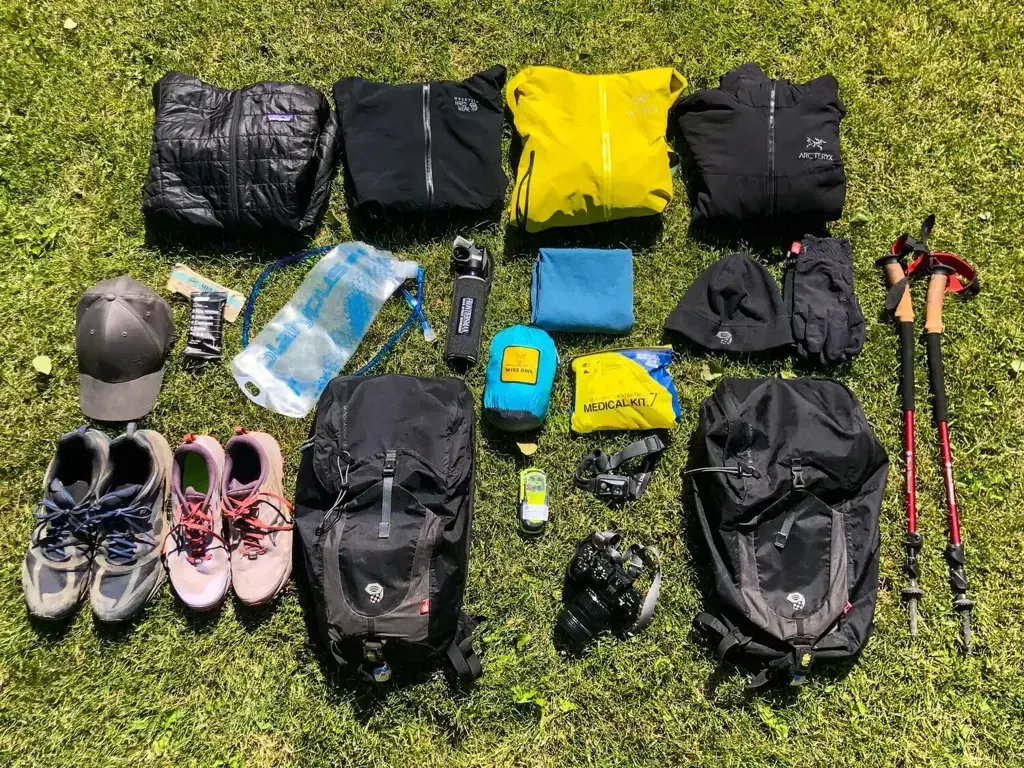
When heading out for a day hike in Utah, it's crucial to be prepared and bring along the necessary safety items and equipment. Utah's beautiful landscapes offer a plethora of hiking opportunities, but they can also present some unique challenges. To ensure a safe and enjoyable experience, here are some essential items you should consider including in your day hike kit:
- Navigation Tools: It's important to know where you're going and have the means to navigate the trails. Bringing a map and a compass is essential. In addition, consider carrying a GPS device or a smartphone with reliable navigation apps or offline maps.
- Sun Protection: Utah is known for its hot and sunny weather, so protecting yourself from the sun is crucial. Bring a hat, sunglasses, and apply sunscreen before and during your hike. Additionally, lightweight and breathable clothing with UPF protection can help shield you from harmful UV rays.
- Water and Hydration System: Staying hydrated is essential for any hike, especially in Utah's arid conditions. Carry enough water for the duration of your hike and consider bringing a water purification system or water filter if you plan on refilling from natural water sources.
- First Aid Kit: Accidents can happen on the trail, so it's essential to have a well-stocked first aid kit. Include items such as bandages, adhesive tape, antiseptic wipes, pain relievers, and any necessary personal medications. Familiarize yourself with basic first aid techniques and carry a guidebook if needed.
- Emergency Shelter: A lightweight emergency shelter such as a space blanket or a bivy sack can provide protection in case of unexpected weather changes or emergencies. These items can provide warmth and shelter until help arrives or until you're able to make your way back to safety.
- Extra Clothing: Even on hot Utah days, temperatures can drop significantly at higher elevations or during unexpected weather events. Carry extra layers of clothing, including a warm hat and gloves, to stay prepared for changing conditions.
- Whistle and Signal Mirror: These small and lightweight items can be life-saving in emergency situations. It's easier to be located by rescuers if you can produce a loud sound with a whistle or reflect sunlight with a signal mirror.
- Emergency Communication Device: In case of emergencies or when cell service is limited or non-existent, having a personal locator beacon (PLB) or satellite communicator can greatly increase your chances of getting help when needed. These devices allow you to send messages and your location to emergency services or family members.
- Snacks and Emergency Food: Bring high-energy snacks and emergency food that doesn't require cooking. These can sustain you in case of delays or unexpected situations that might extend your time on the trail.
- Knowledge and Preparation: Along with the physical items, ensure you're adequately prepared by researching the trail you'll be hiking, checking the weather forecast, and informing someone about your plans. Maintain a realistic understanding of your fitness level and choose a hike that matches your capabilities.
Remember, the above list is a starting point, and you should tailor your day hike kit based on the specific trail, length, and difficulty of your hike. It's always better to be over-prepared than under-prepared when it comes to safety in the outdoors. By bringing the necessary equipment and being adequately prepared, you can have a safe and enjoyable day hike in Utah's beautiful wilderness.
Essential Items to Pack for a Memorable Summer Trip to Lake Tahoe
You may want to see also

Are there any specific food and water recommendations for staying hydrated during a summer hike in Utah?
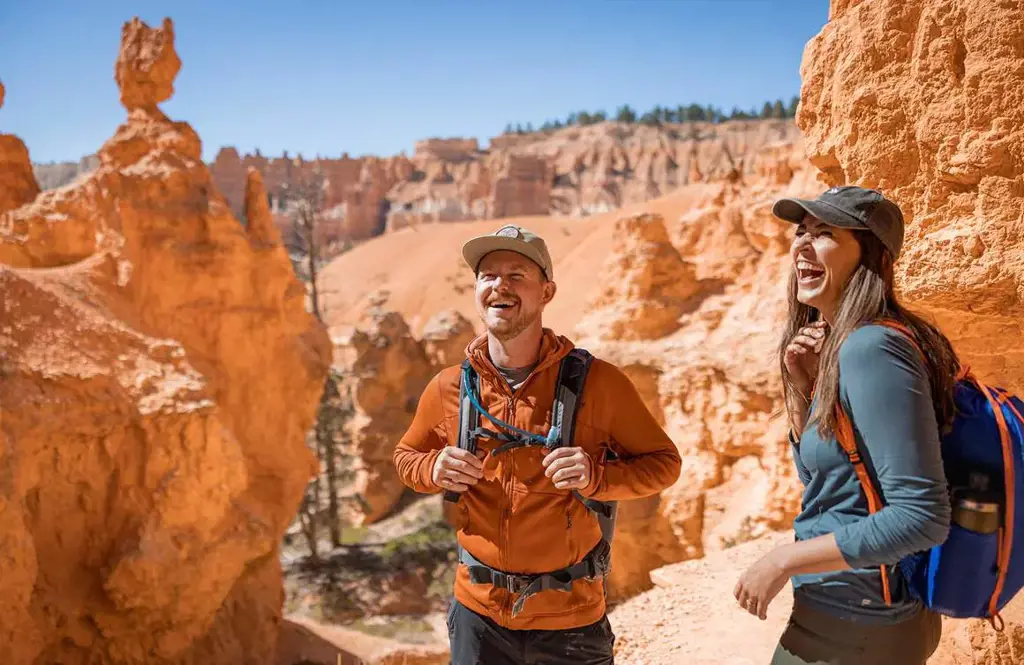
Staying hydrated is important during any outdoor activity, but it becomes even more crucial during a summer hike in Utah due to the hot and dry climate. Proper hydration can prevent heat-related illnesses and help you perform better on your hike. Here are some specific food and water recommendations to ensure you stay hydrated during your summer hike in Utah:
- Start Hydrating Before Your Hike: It's essential to start your hydration efforts well before you hit the trail. Drink plenty of water the day before your hike to pre-hydrate your body. This will help ensure that you start your hike in a hydrated state.
- Carry Sufficient Water: The most crucial factor in staying hydrated during a summer hike is carrying enough water. The amount of water you need depends on various factors such as the length and intensity of your hike, temperature, and your individual hydration needs. As a general rule, aim to carry at least one liter of water per hour of hiking. If you anticipate a long or challenging hike, consider carrying a hydration bladder or water purifier to replenish your water supply along the way.
- Consider Electrolyte Replacement: During long hikes, especially in hot weather, you may lose essential electrolytes through sweat. To replenish these electrolytes, consider carrying electrolyte-rich drinks or electrolyte tablets. These can help maintain your body's fluid balance and prevent dehydration and cramping.
- Snack on Hydrating Foods: While drinking water is crucial, you can also consume hydrating foods to help maintain your hydration levels during the hike. Opt for fruits and vegetables with high water content, such as watermelon, cucumber, oranges, and strawberries. These foods not only provide hydration but also offer essential vitamins and minerals.
- Avoid Excessive Alcohol, Caffeine, and Sugary Drinks: When hiking in hot weather, it's best to limit or avoid excessive alcohol, caffeine, and sugary drinks. These can increase your urine output, leading to dehydration. Stick to water, electrolyte drinks, or natural fruit juices to stay properly hydrated.
- Take Frequent Water Breaks: During your hike, take frequent breaks to rehydrate. Don't wait until you're thirsty, as thirst is a sign that you're already dehydrated. Set a reminder to drink water every 15-20 minutes, even if you don't feel parched. This will help you maintain a steady fluid intake throughout your hike.
- Monitor Urine Color: A simple way to check your hydration status is by monitoring the color of your urine. If it's light yellow or clear, it indicates that you're well-hydrated. Dark yellow or amber urine is a sign of dehydration and a signal to drink more fluids.
- Be Mindful of Hydration Levels in Higher Altitudes: Utah has numerous hiking trails that reach high altitudes. It's important to note that dehydration can occur more quickly at higher altitudes due to increased respiration and evaporation. Be extra cautious and stay vigilant about your hydration needs when hiking at higher elevations.
By following these food and water recommendations, you can stay properly hydrated during your summer hike in Utah. Remember, staying hydrated is not only vital for your comfort but also for your overall health and safety. A well-hydrated body will keep you energized, focused, and ready to conquer the stunning Utah trails ahead.
Essential Items to Pack for a Memorable Trip to Joshua Tree
You may want to see also
Frequently asked questions
When preparing for a light day hike in Utah during the summer, it's important to pack essential items to ensure your safety and comfort. Start with a sturdy pair of hiking shoes or boots that provide good traction. Additionally, pack plenty of water to stay hydrated in the desert heat. It's recommended to bring at least 2 liters of water for a day hike. Sun protection is crucial in Utah's intense summer sun, so don't forget to pack sunscreen, a hat, and sunglasses. It's also a good idea to bring a lightweight, long-sleeved shirt and pants to protect your skin from the sun and possible brush or insects on the trail. Lastly, don't forget to bring a small backpack to carry all of your items, as well as snacks, a first aid kit, a map or GPS device, and a camera to capture the beautiful Utah scenery.
Yes, there are a few specific items you should bring for a day hike in Utah's desert. In addition to the usual hiking essentials, it's important to bring a lot of sunscreen. The desert sun can be incredibly intense, so be sure to apply sunscreen liberally and frequently throughout the day. It's also a good idea to bring a wide-brimmed hat to provide maximum shade for your face and neck. In addition, consider bringing a bandana or Buff to protect your neck and face from the sun and dust. Finally, because of the arid conditions and potential for high heat, it's important to bring more water than you think you'll need. It's always better to have too much water than not enough, so pack extra bottles or a hydration bladder to stay properly hydrated during your hike.
When hiking in Utah's summer, it's crucial to take extra safety precautions due to the extreme heat and arid conditions. Start by planning your hike for early morning or late afternoon when temperatures are cooler. Avoid the hottest part of the day, generally between 11 am and 3 pm. Additionally, be mindful of the signs of heat exhaustion and heat stroke. Watch for symptoms such as dizziness, rapid heartbeat, nausea, or confusion, and take immediate action if you or a hiking partner show any signs. It's also important to know the signs of dehydration and drink water regularly throughout your hike, even if you don't feel thirsty. Finally, ensure that someone knows your hiking plans and expected return time. This way, if something goes wrong, someone will know to look for you.
In addition to the essentials mentioned earlier, there are a few other items you should consider bringing on a light day hike in Utah's summer. One important item is insect repellent. While Utah's desert may not be as buggy as other areas, mosquitoes and other insects can still be present, especially near water sources. It's also a good idea to pack a small, lightweight towel to wipe off sweat or dry off after a dip in a river or lake. Additionally, consider bringing a whistle in case of emergencies. A whistle can be heard from a much greater distance than yelling, making it easier for rescue teams to locate you if needed. Finally, it's always a good idea to have a basic knowledge of first aid and bring a small first aid kit with you on your hike. This way, you'll be prepared for any minor injuries or emergencies that may occur.



